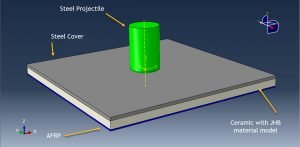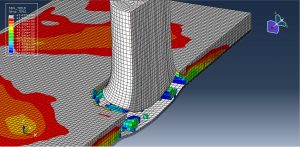In this tutorial, the Simulation high-velocity impact of the steel rod to the composite panel(Steel-Ceramic-AFRP) in Abaqus has been done. The steel rod and steel cover are modeled as three-dimensional solid part. The ceramic part is modeled as a three-dimensional solid part. The Aramid Fiber Reinforced Plastic(AFRP) is modeled as a three-dimensional solid part with four layers. You can see a figure of the assembled parts below
The steel material with Johnson-Cook plasticity and damage is used to model projectile and the steel cover layer. The Johnson-Cook plasticity model is a particular type of Mises plasticity model with analytical forms of the hardening law and rate dependence. It is suitable for high-strain-rate deformation of many materials, including most metals and typically used in adiabatic transient dynamic simulations. To model AFRP composite material, lamina elastic behavior and Hashin’s damage criterion is selected. Abaqus offers a damage model enabling you to predict the onset of damage and to model damage evolution for elastic-brittle materials with anisotropic behavior. The model is primarily intended to be used with fiber-reinforced materials since they typically exhibit such behavior. Damage initiation refers to the onset of degradation at a material point. In Abaqus the damage initiation criteria for fiber-reinforced composites are based on Hashin’s theory. To model ceramic behavior the Johnson-Holmquist-Beissel is used. The JHB model consists of three main components: a representation of the deviatoric strength of the intact and fractured material in the form of a pressure-dependent yield surface, a damage model that transitions the material from the intact state to a fractured state, and an equation of state (EOS) for the pressure-density relation that can include dilation (or bulking) effects as well as a phase change. The dynamic explicit step is appropriate for this type of analysis. The general contact algorithm is selected to consider all contacts in the contact domain. The perfect contact is assumed between ceramic-AFRP and ceramic-steel cover. The fixed boundary condition is assigned to two sides of the panel and initial velocity to the steel projectile. The mesh should be fine to obtain correct results
After the simulation, all results such as stress, strain, damage criteria for all parts, velocity diagram, failure, .. are available. You can see some figures for the results below







You can provide CAE ,INP,and English video files of this simulation here. The cost of these files is Twenty-Seven Euros. you can click on the bellow bottom to beginning process
You can purchase the tutorial through a PayPal account, a Visa, or a Master card, just before payment, send me an email to this address: karampourp@gmail.com
 Abaqus tutorials Abaqus tutorials
Abaqus tutorials Abaqus tutorials




